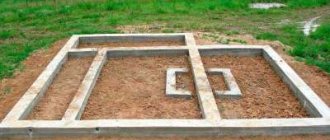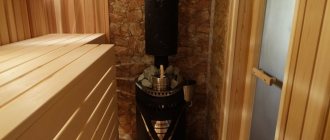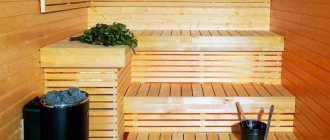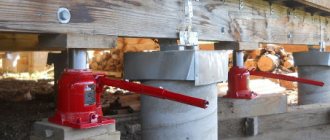Proper organization of bath procedures is not such a simple matter. The main difficulty is to get light and truly useful vapor, and not heavy and suffocating. To achieve this using a regular heater, you need to be an expert in the bath business, but today special devices are being produced - steam generators and steam guns, with the help of which even a beginner can get high-quality steam. Now we will not only get to know these bathhouse devices better, but also learn how to make them with our own hands.
Types of baths
Homemade steam generator for a bath
Steam is formed by the evaporation of water. They get it in different ways. The effectiveness of steaming and the bathing procedure itself depends on what kind of steam is produced, what temperature is maintained and how it is maintained. There are 3 options for steam baths.
- Sweat - sweat room. Here a person “washes himself” with his own sweat. In a Finnish sauna, sweating is achieved by high temperature, in a Russian sauna by relatively high temperature and whipping with a broom, in a hammam by high humidity. In the sweat room, a steam installation is not needed.
- Steam room - condensation from high-humidity air forms on human skin. Steam is obtained here by pouring water or kvass onto hot stones.
- Shaeck - the steamer is washed with warm water from numerous basins, checkers, barrels by splashing and dousing. It differs from a shower or bath in its short interaction with water. The main condition of the gang is that the temperature is high enough so that after dousing the person does not feel cold.
The need for steam generation appears in traditional Russian steam rooms and their analogues.
Water supply methods
Water is supplied to the steam generator tank using two methods:
- self-filling of water by the user;
- automatic supply from the water supply.
If you make a steam generator for a bath yourself, then automatic water supply is more difficult to implement. Another disadvantage of this scheme is that the content of impurities in tap water or its increased hardness quickly provokes the formation of scale, which will require frequent cleaning. When filling the reservoir manually, you can use distilled water.
You can also familiarize yourself with the reasons why water may leak from the steam generator.
Steam Features
Depending on the type of bath, the steam in the steam room differs.
Bath masters distinguish many types of steam. Depending on the temperature conditions in the steam room, several steam-air mixtures are formed from floor to ceiling.
A steam installation in a bathhouse can generate the following types of steam.
- Burning – supersaturated steam. Creates a hot dew on the skin and then turns into a rich dew. Such steam burns your lips and mouth upon entry and is “visible” as clouds of fog.
- Light – overheated, but not rich. It cools around the person, and only when it reaches the condensation point does it form dew on the skin. It does not burn - it tingles the ears, transfers heat deep into the nasopharynx and even the bronchi and is considered the most useful in the treatment of diseases of the respiratory system. No steam is visible.
- Damp – Contains droplets of water or mist. It usually results from the explosive evaporation of water on a coarse-textured surface. In this case, the water does not evaporate completely and forms separate drops. It is not very pleasant, as it creates a contrast between pleasant fine steam and large, highly heated drops.
To prevent the production of raw steam, sprinklers are often installed on the heater. They allow evaporated water to pass through, but trap droplets.
The benefits of visiting a steam room
Especially in the cold season, our body requires more heat. The easiest way to compensate for its lack is to visit a steam room in a sauna or bathhouse. Such procedures give our body many benefits that you don’t even think about. Firstly, under the influence of hot steam the entire body warms up. This increases blood flow, the internal organs are enriched with oxygen and this improves their performance. The procedure also has a positive effect on the immune system, increasing it. Secondly, from exposure to hot steam, the body begins to release a large amount of liquid, i.e. sweat, and with this fluid, toxins and other harmful substances are removed from the body. This regimen also helps in losing weight, because at the same time the metabolism becomes higher, which helps in the breakdown of fats. Such procedures can even be prescribed by nutritionists.
But to ensure that visiting the steam room does not cause undesirable consequences, you must follow some rules. You should not be exposed to steam for more than 5 minutes, and after that time you need to cool down in the pool, shower, or just lie down in a cool place. The next visit to the steam room should be no earlier than 15 minutes later. Also, during the rest period, you should replenish the water lost by the body. Drinking various teas, water, and herbal infusions is allowed. It is not recommended to drink alcohol in the bathhouse. Don’t forget to wear a special headdress when visiting the steam room, otherwise heat stroke may occur.
Differences between a steam generator and a steam gun
A steam gun is placed on the heater so that the water gets into the lower part of the oven, where the stones are hotter.
The traditional method of producing steam is a heater. However, using it requires some experience and skill. Otherwise, it will be difficult to achieve light steam. Special devices - a steam gun and a steam generator for a bath - cope better with this task.
What is a steam gun
The heater heats up most strongly at the bottom, while water is splashed on the top. Because of this, you have to either heat the stones much hotter, or be content with not very good steam.
A steam gun is a design that allows you to deliver water directly to the lower stones. It is a thick-walled pipe with holes, which is placed at the bottom of the heater. The second part of the pipe is fixed perpendicularly and equipped with a funnel. Pour water into it. The water goes to the bottom of the heater and comes into contact with the hottest stones. This produces light steam.
Minus: while the steam reaches the top stones, it partially cools. Therefore, sometimes they install a steam outlet that removes steam through a separate channel.
How does a steam generator work?
Electric steam generator
A steam generator is an electrical device that is in no way connected with the stove. It works like a kettle, but does not turn off when the water reaches the boiling point. The steam generator is equipped with a valve and valve, and the housing is sealed. This allows you to obtain finely dispersed superheated steam without droplets.
There are several types of devices:
- electrode – water is heated by electrodes;
- induction - the circuit through which water circulates is heated due to self-induction currents;
- Heating element – analogue of an electric kettle or boiler;
- stove - the chamber is mounted in the firebox of the stove, where it is heated by an open fire.
You can make a stove and heating element version with your own hands.
Tips for installing and operating steam generators
To extend the service life of the steam generator and ensure its safe use, you must adhere to the following rules:
- To ensure safety, the electric steam generator is installed not in the steam room, but in an adjacent room.
- The steam supply line should be as short as possible - this way the steam will not have time to cool down.
- The steam line is made inclined to avoid the accumulation of condensate after the unit is turned off.
- Connection to the electrical network is carried out with a grounding loop and an RCD, the leakage current of which should not exceed 30 mA.
- It is better to equip a container with a vapor-forming liquid with an audible alarm of any type - this will prevent operation without water, and as a result, burnout of the heating element.
- It is not recommended to use tap water - it is better to pass it through a filter.
- For a healing effect, purified herbal infusions and aromatic oils can be added to the liquid.
- Periodically, the elements of the steam generator are descaled by pouring a solution of citric or acetic acid into the device.
With minimal plumbing skills, you can build a steam gun or steam generator for a bath in one day. These simple devices will allow you to get a sufficient amount of high-quality steam. From now on, visiting the steam room will become extremely pleasant, and its healing effect on the body will reach a level that only a real Russian bath can provide.
- Author: Victor Kaploukhiy
Thanks to my varied hobbies, I write on various topics, but my favorites are engineering, technology and construction. Perhaps because I know many nuances in these areas, not only theoretically, as a result of studying at a technical university and graduate school, but also from the practical side, since I try to do everything with my own hands. Rate this article:
- 5
- 4
- 3
- 2
- 1
(7 votes, average: 4.7 out of 5)
Share with your friends!
What to choose for a bath
You need to choose a means for generating steam taking into account the nature of the bath.
- Finnish sauna - characterized by high temperature - up to +120 C, and low humidity - 15%. Such heat at high humidity is very difficult to tolerate, so it is important to obtain superheated steam in small portions. A steam gun with a steam outlet pipe is much more suitable for this role.
- In the steam room, the temperature rises no more than +80 C, but the humidity is higher - up to 70–80%. Here steam is needed, and in different quantities depending on the nature of the procedure. It is much more convenient to use an independent device - a steam generator. However, it is very important to choose it based on performance, since you need a lot of steam.
- The hammam requires very high humidity - up to 100%, but low temperature - no more than +45 C. Here you can easily do without both devices, since the steam is needed wet, heavy - damp. If the need arises for heated steam, a steam generator is installed.
Additional alternative devices are selected taking into account the power and design of the heater.
Common causes of breakdowns and do-it-yourself repairs
Most often, steam generators fail for the same reasons:
- Work dry (if the water has evaporated and a new portion has not been added).
- Ten burns due to scale.
- Manufacturing defects.
Industrial models are equipped with protective mechanisms against dry heating and power surges, and turn off the device in a timely manner.
When using homemade equipment, be careful!
To prevent scale formation, it is recommended to periodically boil water with acetic or citric acid. And use “soft” water.
So, a small device, a steam generator for a sauna, will free the bath attendant from the need to monitor the amount of steam and constantly “supply”; the device can maintain a certain air temperature, and any owner can equip his sauna with a homemade device.
Making a steam generator
A steam generator from a gas cylinder
The easiest way is to make a stove steam generator with your own hands. To do this, cavities are welded on the inner wall of the firebox. Water is poured into them through a watering can, and steam is removed using a steam outlet. In this way, only saturated steam is obtained, most often raw. But since it is mixed with a large volume of heated air and steam produced on the heater, the result turns out to be quite worthy.
With some skill, you can make an electric steam generator for a bathhouse with your own hands. For this model you will need:
- gas cylinder with a volume of 27 l;
- heating elements or other tubular heaters;
- paronite gaskets, safety valve, tap and ball valve;
- corrugated metal hose or pipe;
- pressure gauge;
- welding machine;
- grinder, drill, keys.
You will also need a variety of connecting parts and gaskets: bends, couplings, fum tape.
Milk can steam generator
Work begins with the preparation of materials. The gas cylinder is emptied, the valve is turned off and the gas condensate is drained. Then fill the container with water so that the liquid displaces the remaining gas.
- Cut off the top of the cylinder along the weld seam. The inside is washed with detergents.
- In the lower part, at a distance of 1 cm from the bottom, holes are drilled for heating elements of the same diameter. The heating elements are installed so that they do not touch and sealed with gaskets.
- At a height of 10 cm from the bottom, a pipe for supplying water is cut into the container. A heat-resistant hose is placed on it and lowered into a transparent container: this vessel will be used to determine the water level in the apparatus.
- A pressure gauge and a safety valve are attached to the cut off lid. It is better to choose a device with an electric relay that can turn off the heating elements when a certain pressure is reached.
- The steam line is connected to the valve using a throttling element. This role is played by a 50 cm piece of steel pipe with holes 2–3 mm in diameter. The element allows you to release a little steam so that the latter does not escape from the hose under too high pressure.
- The body of the electric heater is equipped with a U-shaped lock. A rubber seal is placed in its recess.
- L-shaped iron studs with a diameter of 10 mm and nuts of 12 mm are welded onto the walls of the cylinder and onto the side parts of the roof.
- All parts of the generator are assembled together.
It is not recommended to connect all parts by welding. In this case, the heating element will have to be cut off with a grinder for repair.
Selection of capacity
There is an opinion that the best solution for a steam generator in a Finnish sauna is a 6-10 liter gas storage cylinder. Often they choose containers for storing freon, isobutane, propane, carbon dioxide and even oxygen. Cylinders are used to construct a high-pressure steam generator. Usually they take small-sized oxygen and carbon dioxide containers with a wall thickness of at least 5-8 mm.
If you make a steam generator from a cylinder, then it is best to use an old, but still intact sprayer
From a cylinder you can make a steam generator in which water will boil under pressure, like in a steam engine. You can find generator models with operating pressures up to 3 Bar, but there are also higher ones. The point of this cylinder design is that the steam flow is heated to a higher temperature, about 120-140°C, so the steam in the bath is hotter and drier.
In practice, only an experienced master welder can make a steam generator for a bath from a cylinder:
- You will need to cut the container and rinse the inside from dirt;
- Install a heating element or even a block of electric heaters into the wall;
- Install a water supply pipe, an emergency relief valve and a pressure gauge for hot media;
- Assemble the cylinder, weld or connect using welded flanges.
Even if it is possible to make such a generator at home, the design will still be unsafe for use in a bathhouse, and such a steam generator has no tangible advantages. In addition, repair and maintenance of the device will be difficult, and according to reviews of many home-made workers, the steam in the bathhouse produces a rusty smell.
For a home bath, it is best to use a ready-made container. A 5-20 liter steamer is ideal for building a steam generator. The cover is easily removed and there is a ready-made excess pressure relief valve. You just need to install heating elements and a supply tube for supplying hot water.
Pressure cookers make the best steam generators for any sauna
You can weld a rectangular container from stainless steel sheet, 1.5 mm thick. Of all the options for a bath, this is the best, the service life of the device is unlimited, and there will be no problems with the smell.
How to make a steam gun in a bathhouse
Parts for making a steam gun
A steam gun for a sauna stove can be made even faster with your own hands. Required:
- stainless steel funnel;
- corrugated pipe 2.5 m long;
- tee, adapter angle, connector (barrel) ½ inch;
- connection fittings;
- check valve;
- metal hacksaw, scissors;
- welding machine;
- electric drill with drills with a diameter of 2 to 5 mm;
- keys.
You can make a check valve yourself. It will require a 10*10 cm steel sheet and spring wire.
Install the evaporator using the step-by-step instructions.
- A structure of the desired configuration is assembled from angles, tees and connectors. The scheme of the latter is chosen depending on the volume and shape of the heater.
- Cut a piece of corrugated pipe 50–100 cm long and connect it with an angle to a fitting.
- A check valve and a threaded fitting are mounted and connected to a corrugated pipe for water supply. Instead of corrugated one, you can use regular tap water, but then you need to cut threads around the edges.
- In the horizontal part of the device, which will supply water to the stones, holes with diameters of 1–3 mm are drilled. The distance between them is up to 5 cm.
- The steam gun is placed at the bottom of the grid and filled with stones. The watering can must remain above the level of the slide.
Test the device with a small amount of liquid while heating the oven at half power. If the test is successful, repeat the test at full power.
Installation of heating elements
The model of the electric heating unit must be selected based on the size and shape of the main tank of the steam generator. For a double boiler, a heating element with a round loop is best suited. For a narrow and elongated steam generator, it is best to use classic U-shaped heaters in a titanium housing.
To install the heaters, you will need to cut a hole in the wall of the tank so that the heating part is 20-25 mm from the bottom. The mounting housing of the heating element consists of two halves, usually made of heat-resistant plastic. You will need to lay a gasket made of heat-resistant silicone and insert it into the hole of the heating element, the outer part of the housing and tighten the heater with a key or screwdriver.
Self-tightening heaters from washing machines are practically not used in steam generators for baths due to the characteristic method of fastening. Such a heating element can be installed in a low-pressure generator, but this will require welding an adapter ring into the wall of the tank.











